A cape dress describes a woman’s dress which combines features of the cape and the dress.
Either a cape-like garment is attached to the dress, pinned or sewn on, and integrated into its construction, or the dress and cape are made to coordinate in fabric or color. Cape dresses provide a modest double layer in the bodice area. They also provide a long, full skirt that conceals the form and falls at least below the knee and sometimes down to the ankle.
In the 19th and 20th centuries, popular female fashion changed radically to be more form-fitting and revealing. At the same time, the cape dress continued to be worn by women who were members of conservative, traditional Mennonite and other Anabaptist communities. The cape dress has a plain style, and a double layer of fabric covers the bodice. This piece of fabric has a square or V-shaped form and cloaks or de-emphasizes the female form. Besides that, it continues to be a statement of nonconformity to the world, especially against rapid and dramatically changing, body revealing fashions from the end of the 19th century onwards.
The cape dress has occurred in different variations in fashion and film. For example, Greta Garbo wore an Art Deco-inspired cape dress in the film The Torrent (1926). The dress has a geometrical black-and-white pattern and a stiff round ruff. The cape dress was also popular in the 1950s. Two types were prominent at the time: a full-skirted, sleeveless dress with a matching, elbow-length cape or a beltless, sheath dress with a matching cape.
In the Victoria and Albert Museum collection, various cape dresses can be found. In 1933 Madeleine Vionnet created a woolen jersey dress and matching cape.[7] Coco Chanel designed a dress with a matching cape in 1937-8. The dress consisted of silk and a net covered with black sequins. It was lined with satin. In 1967 Cristóbal Balenciaga created an evening ensemble consisting of a matching cape and sleeveless dress out of black gazar silk. Philippe Venet created a black-and-white dress with a cape-like collar in 1989.
Recently, the cape dress has occurred in different collections of fashion designers:
- Stéphane Rolland created various cape dresses in black, blue, and white in his Fall 2010 collection.
- Gwyneth Paltrow wore a white cape and dress by Tom Ford to the Oscars in 2012.
- Queen Máxima wore a dress and matching cape by Jan Taminiau during the inauguration of King Willem-Alexander on 30 April 2013 (Netherlands).
- Lupita Nyong’o wore a red cape dress by Ralph Lauren to the Golden Globe Awards in January 2014







Add Comment